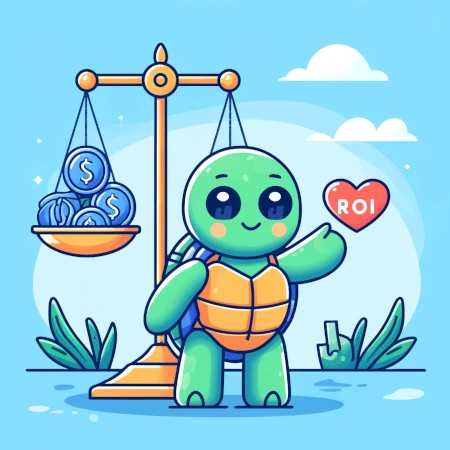Return On Investment
Make it worth the effort

Definition
Return on Investment (ROI) is a metric used to evaluate the efficiency or profitability of an investment. It measures the amount of return on an
investment relative to its cost, providing a simple formula: Value Gained / Cost of Activity. ROI helps prioritize activities that offer the highest
value relative to their cost, applicable in business, projects, or personal decisions.
Key Components
- Value Gained: The benefit or return derived from the investment, which can be monetary or intangible.
- Cost of Activity: The total expense incurred to achieve the value gained.
Background
Origin
The concept of ROI dates back to early economic theories and has been a fundamental metric in finance and investment analysis for decades. It provides a straightforward way to compare the profitability of different investments or projects.
Application
In business, ROI is frequently used to assess the profitability of projects, marketing campaigns, or any strategic investments. While the basic formula is straightforward, accurately defining and quantifying both “value gained” and “cost” can be challenging. ROI can also be applied to personal investments, such as education or career development, where the returns may include both financial and non-financial benefits. While this monetary approach is undoubtedly useful, it doesn’t capture all the gains, some of which are intangible. Some people will attempt to assign a financial value to everything in life, which can be ethically challenging.
warning: ROI is a decision-making tool, and its effectiveness depends on the context and the accuracy of the data used.
Comparisons
Financial Metrics
ROI is often compared with other financial metrics such as Net Present Value (NPV) and Internal Rate of Return (IRR). While NPV and IRR consider the time value of money, ROI offers a simpler, more intuitive calculation, making it widely used for quick assessments. However, unlike these more complex metrics, ROI does not account for the time period of the investment, which can be a limitation in long-term projects.
Similar to ROI but more detailed, Cost-Benefit Analysis (CBA) evaluates all costs and benefits, including indirect and non-monetary ones, offering a thorough evaluation of the project’s overall worth. CBA provides a comprehensive view by factoring in intangible benefits and externalities, making it a more holistic approach to evaluating investment decisions. However, this thoroughness comes with increased complexity and the challenge of quantifying non-financial elements.
Value-Based Evaluations
Value-based evaluations consider the broader impact of an investment, including financial returns, social value, environmental impact, and alignment with ethical standards. These evaluations often use metrics like Social Return on Investment (SROI), which measures the social, environmental, and economic value created by an investment. The goal of value-based evaluations is to maximize overall value by considering both tangible and intangible benefits and costs. They integrate ethical standards and consider the broader impact on stakeholders and society, but they are significantly more complex to assess.
Risk Assessment
Risk assessment involves identifying, analysing, and prioritizing potential risks associated with an investment. Unlike ROI, which primarily focuses on financial returns relative to costs, risk assessment provides a more comprehensive view of the uncertainties and potential downsides of an investment. This process involves evaluating the likelihood and impact of various risks, which can include market volatility, operational challenges, and external factors such as regulatory changes. By incorporating risk assessment, decision-makers can better understand the potential challenges and develop strategies to mitigate them, leading to more informed and resilient investment choices.
Spontaneous Decision-Making
In contrast, “just doing whatever comes to mind” is the spontaneous and unstructured approach to decision-making that most people use on a daily basis. This method lacks the analytical rigour of ROI, often leading to inconsistent outcomes as decisions are made based on immediate impulses or random choices rather than calculated evaluations. While this approach might occasionally lead to innovation or unexpected successes, it typically lacks the focus and predictability that ROI provides. Without a framework to assess potential gains and costs, resources can be misallocated, opportunities can be missed, and strategic goals can remain unmet. Therefore, while spontaneity can fuel creativity, it is the structured assessment of ROI that ensures sustainable and strategic growth.
Examples
Example 1: Business Investment
Say you are a manager and have three different projects that your team could work on. Each project has been analyzed and assigned an estimated future income and development cost. You can choose one of these projects:
- Option 1: Estimated income = 15,000 EUR; Estimated costs = 5,000 EUR
- Option 2: Estimated income = 1,850,000 EUR; Estimated costs = 750,000 EUR
- Option 3: Estimated income = 1,000 EUR; Estimated costs = 200 EUR
The expected ROI for each option is:
- Option 1: ROI = 200%
- Option 2: ROI = 146%
- Option 3: ROI = 400%
From this analysis, Option 3 provides the highest ROI. If only considering ROI, you might choose to prioritize Option 3.
Example 2: Personal Investment
Consider investing in a professional development course costing 1,000 EUR, which you expect will help you secure a job paying 10,000 EUR more per
year. The ROI would be: ROI = (10,000 EUR / 1,000 EUR) = 1,000%. This high ROI indicates a significant return on your investment in education.